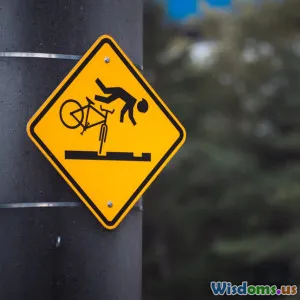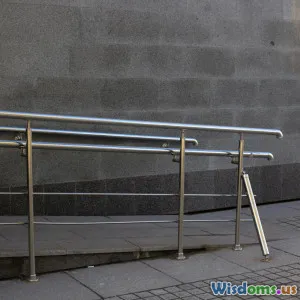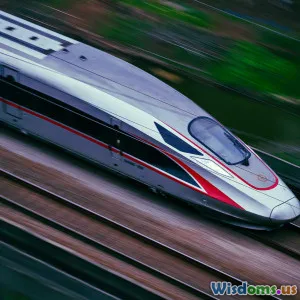
Comparing Raised Crosswalks and Painted Lines for Safer Streets
11 min read An in-depth comparison of raised crosswalks and painted lines reveals which approach best enhances street safety and pedestrian visibility. (0 Reviews)
Comparing Raised Crosswalks and Painted Lines for Safer Streets
Streets are the arteries of our cities, pulsing with cars, cyclists, and pedestrians alike. Yet these shared spaces carry inherent risks, especially for those on foot. Over the years, urban planners, engineers, and safety advocates have searched for effective street design tools to slow traffic, increase pedestrian visibility, and prevent accidents. Chief among these tools are raised crosswalks and painted lines. But which approach truly makes streets safer?
In this article, we will dive into the strengths and limitations of each, informed by real-world studies, expert opinions, and practical urban design considerations. We'll clarify how raised crosswalks and painted lines impact driver behavior, pedestrian confidence, and maintenance demands. Through this lens, readers will gain a nuanced understanding of these two common—but very different—street safety solutions.
Understanding the Basics: Raised Crosswalks vs Painted Lines
What Are Painted Crosswalk Lines?
Painted crosswalk lines are the traditional street markings made with road-grade paint to designate pedestrian crossing zones. Typically white, they range from simple parallel lines to more elaborate zebra stripes or ladder styles.
These markings serve as visual cues for both pedestrians to cross and drivers to yield. Painted lines rely primarily on visibility and legal precedence to shape road behavior. In many countries, failing to yield at marked crosswalks is illegal, reinforcing their safety role.
What Are Raised Crosswalks?
Raised crosswalks take pedestrian safety a step further—not just through visibility but by physically elevating the walking surface above the normal road level. This elevation can be anywhere from 2 to 4 inches or more, serving both as a speed bump and a crosswalk.
By forcing vehicles to slow down to navigate the height change, raised crosswalks create an unavoidable physical reminder to drivers. They also elevate pedestrians closer to sidewalk level, improving their visibility to approaching traffic and enhancing the walking experience.
Impact on Driver Behavior and Speed Reduction
Multiple studies illustrate how these two street designs influence driver speed and attentiveness.
Painted Lines: A Visual Reminder with Limitations
Painted crosswalks depend largely on driver compliance and sightlines. Without additional traffic calming, many drivers fail to reduce speed adequately near marked crosswalks. According to a Federal Highway Administration (FHWA) study, painted crosswalks without accompanying signals or other measures reduce average vehicle speeds by only about 2-3 mph in urban settings.
Moreover, visibility can be compromised by fading paint, low light, or inclement weather, degrading their effectiveness. Drivers distracted or unfamiliar with an area might overlook painted lines, increasing risk.
Raised Crosswalks: Physical Deterrents to Speed
Raised crosswalks offer a more tangible intervention. A 2017 study by the City of Portland found raised crosswalks reduced mean vehicle speeds by up to 12-15 mph near crossing zones, a substantial difference compared to painted lines alone.
The physical bump acts as a natural speed hump, compelling drivers to slow substantially or risk discomfort and vehicle damage. Additionally, the raised profile improves pedestrian visibility, making crossings more evident from greater distances.
Safety Outcomes: Accident Reduction and Pedestrian Confidence
The core measure of success is how these treatments impact pedestrian injuries and fatalities.
Effectiveness of Painted Crosswalks
Painted crosswalks, being one of the oldest safety measures, have mixed safety records. According to the 2009 National Highway Traffic Safety Administration (NHTSA) data, pedestrian crashes at marked crosswalks without traffic control devices were only slightly lower than unmarked mid-block crossings.
However, improvements in paint quality, add-ons like reflective thermoplastic, and increased enforcement can enhance their effectiveness. Painted crosswalks excel in situations where traffic moves slower or in conjunction with other controls like pedestrian signals.
Raised Crosswalks: Proven Safety Enhancements
Raised crosswalks have demonstrably lowered pedestrian crashes in numerous implementations worldwide. For example, the city of New York reported a 40% decrease in collisions at intersections after installing raised crosswalks as part of its Vision Zero initiative.
A case study from Santa Barbara, California showed pedestrian injuries dropped by 50% after introducing raised crosswalks in residential zones. The physical elevation combined with slowed traffic creates a safer, more comfortable crossing.
Moreover, raised designs bolster pedestrian confidence, encouraging walking and fostering a more active street life, which further improves safety through increased vigilance.
Installation Considerations and Urban Design Implications
Practical challenges and local context heavily influence which treatment is ideal.
Cost and Maintenance
Painted lines are a cheaper, quicker option with lower upfront costs. Their main downside is frequent repainting — particularly on busy streets where wear and weather degrade markings rapidly. On average, repainting cycles range from annually to bi-annually depending on traffic and climate.
Raised crosswalks, by contrast, involve more substantial installation costs. They require road surface alterations, proper drainage design to avoid water pooling, and potentially impacts on underground utilities during construction.
Maintenance typically involves occasional surface repairs and clear signage upkeep, but the elevated structure tends to provide lasting visual and traffic-calming benefits.
Impact on Emergency and Freight Vehicles
Raised crosswalks can pose obstacles for emergency responders or heavy freight, potentially slowing emergency vehicle response times. Cities need to carefully plan placement and height, sometimes incorporating speed tables with ramped edges to ease passage.
Painted lines do not physically impede vehicle movement, giving them an advantage where quick access is paramount.
Context Matters: Urban Density, Traffic Volume, and Pedestrian Presence
In high-density urban areas or near schools, raised crosswalks provide critical physical enforcement of speed limits amid heavy pedestrian traffic.
In suburban or lower-speed neighborhoods with sparse foot traffic, painted lines may suffice or be complemented by flashing beacon systems.
Global Perspectives and Real-World Examples
Europe: Widespread Use of Raised Crosswalks
In many European cities like Amsterdam and Copenhagen, raised crosswalks are standard in residential neighborhoods and near schools. These cities integrate raised crossings into their cycling and pedestrian-friendly urban design to reduce car dominance and collisions.
North America: Mixed Use and Growing Adoption
U.S. cities, including San Francisco and Portland, have increasingly installed raised crosswalks as part of larger Vision Zero plans. Yet, due to budget constraints or historic infrastructure, painted lines remain common, especially in less critical zones.
Developing Countries: Cost versus Safety Tradeoffs
Cities in developing countries often face tough decisions balancing cost and safety. Painted lines remain prevalent due to lower installation costs but can have limited efficacy due to poor maintenance and driver compliance issues. Some pilot programs have introduced raised crosswalks in high-risk spots with encouraging results.
Expert Opinions
John Mack, senior planner with a leading urban design consultancy, emphasizes:
"While painted crosswalks serve an important legal and visual function, raised crosswalks compel drivers to act. If safety is a priority, a physical intervention often yields more consistent results."
Elena Rodriguez, a pedestrian safety advocate, states:
"Raised crosswalks boost pedestrian dignity and visibility. They transform streets from vehicle thoroughfares to shared public spaces. This shift is vital for truly safe and livable communities."
Conclusion: Choosing the Right Approach for Safer Streets
Neither raised crosswalks nor painted lines alone are a silver bullet. The evidence clearly shows raised crosswalks provide a stronger physical deterrent to speeding and significantly improve safety outcomes. They create visible, enduring reminders that drivers must share space carefully with pedestrians.
Painted lines remain important, especially where budgets or infrastructure limit extensive intervention. But their effectiveness is often amplified when combined with additional measures like pedestrian signals, lighting upgrades, or speed humps.
For urban planners, safety officials, and community advocates, the key is blending strategies—tailored to the unique traffic patterns, demographics, and design goals of each street. This strategic approach can reduce collisions, elevate pedestrian experience, and transform streets into safer, more vibrant public realms.
As cities worldwide grapple with growing pedestrian populations and road safety challenges, understanding the nuanced strengths of raised crosswalks and painted lines empowers smarter, more effective street design choices.
By weighing safety data, driver behavior, installation logistics, and community needs, we can take confident steps toward streets where every crossing is a secure one.
Rate the Post
User Reviews
Popular Posts


















